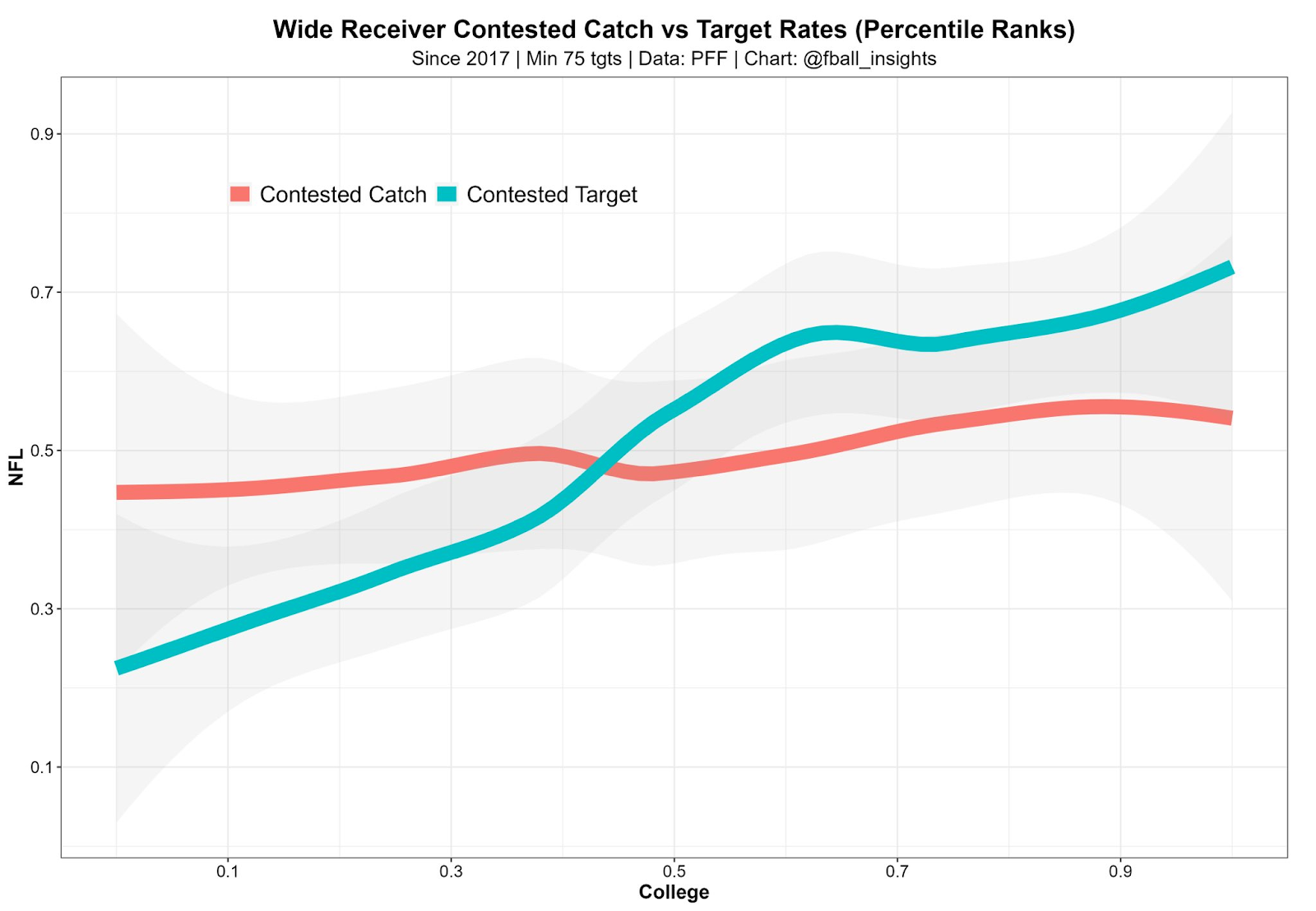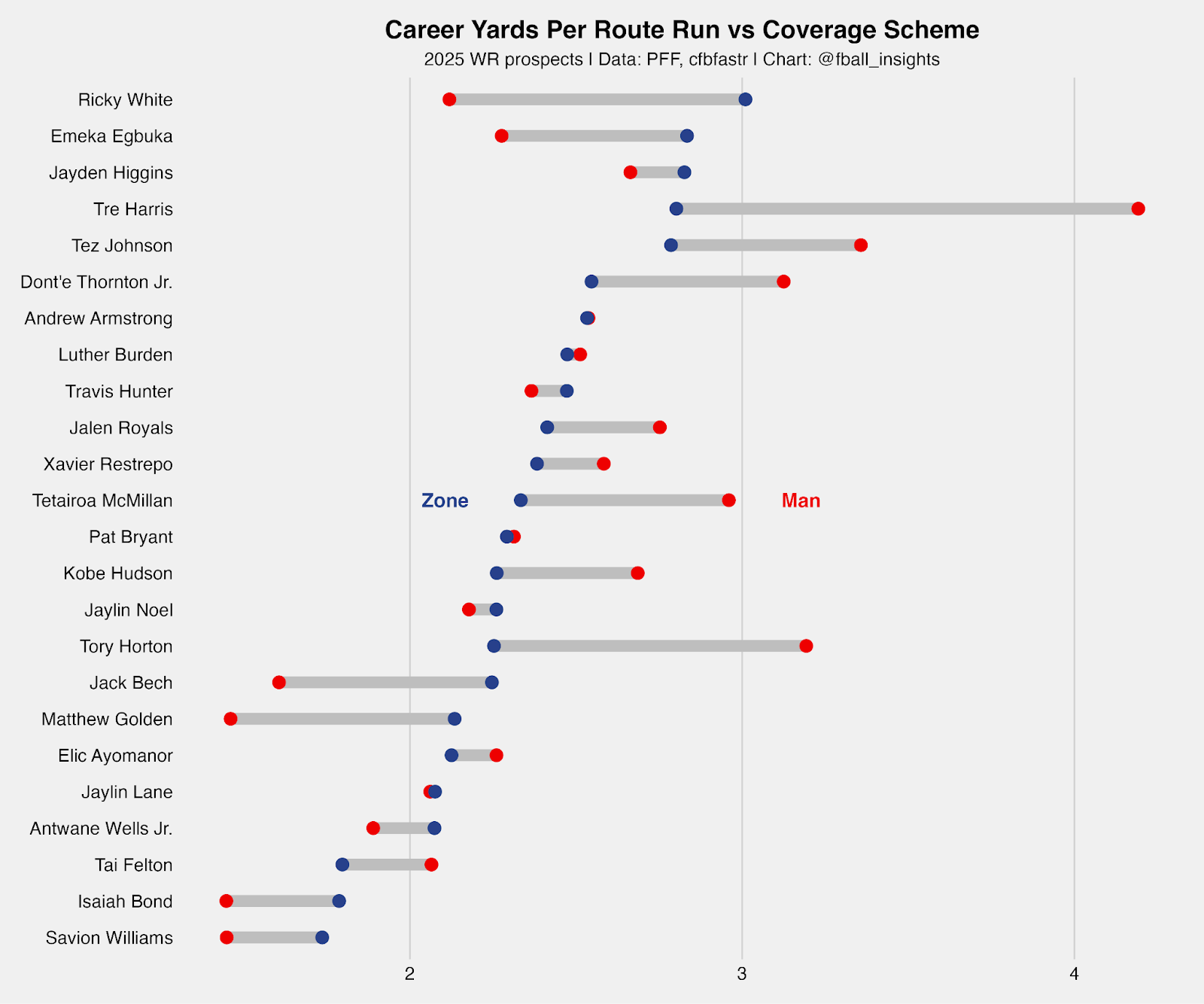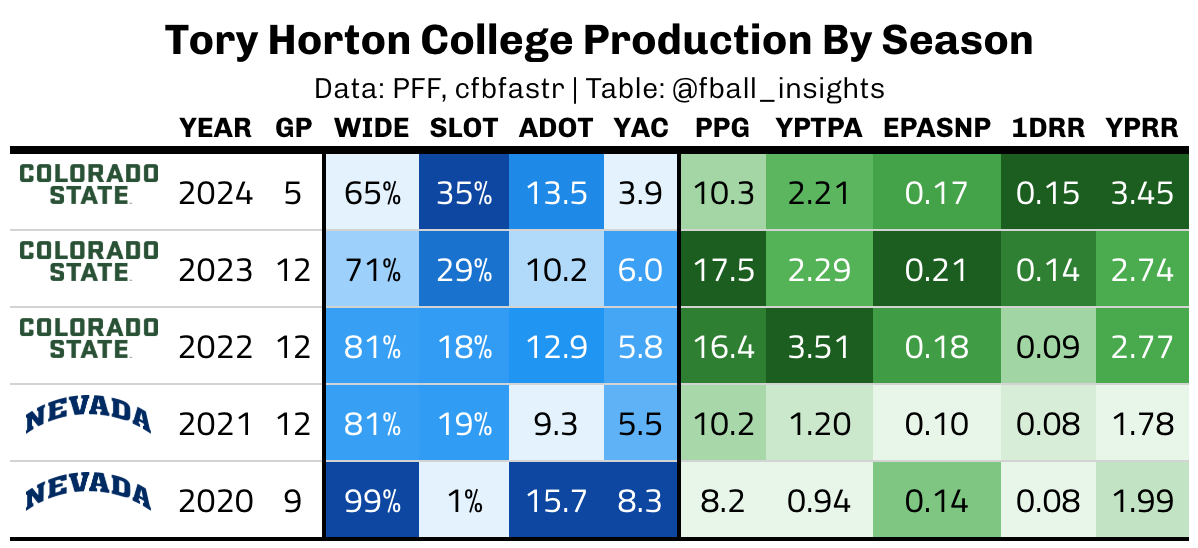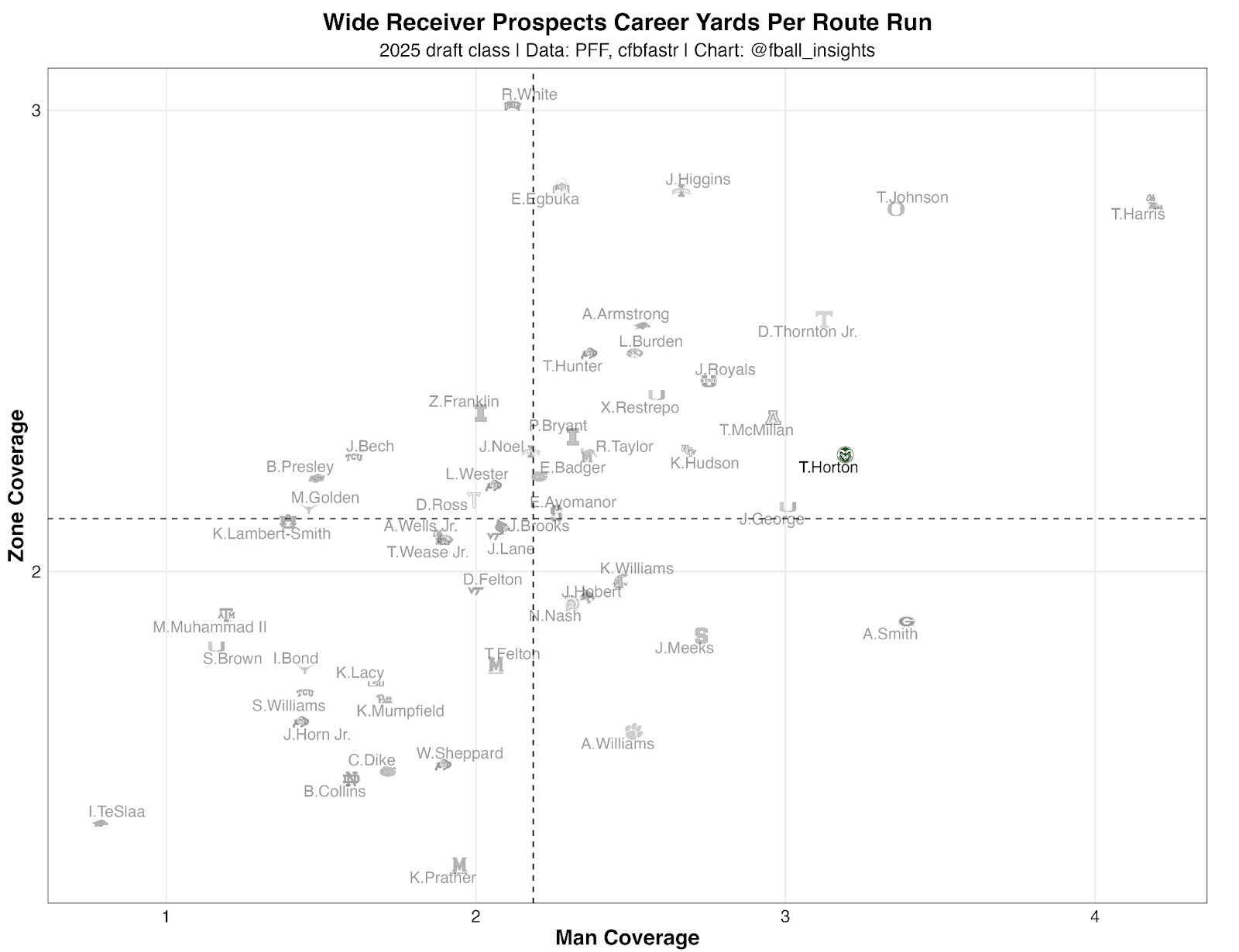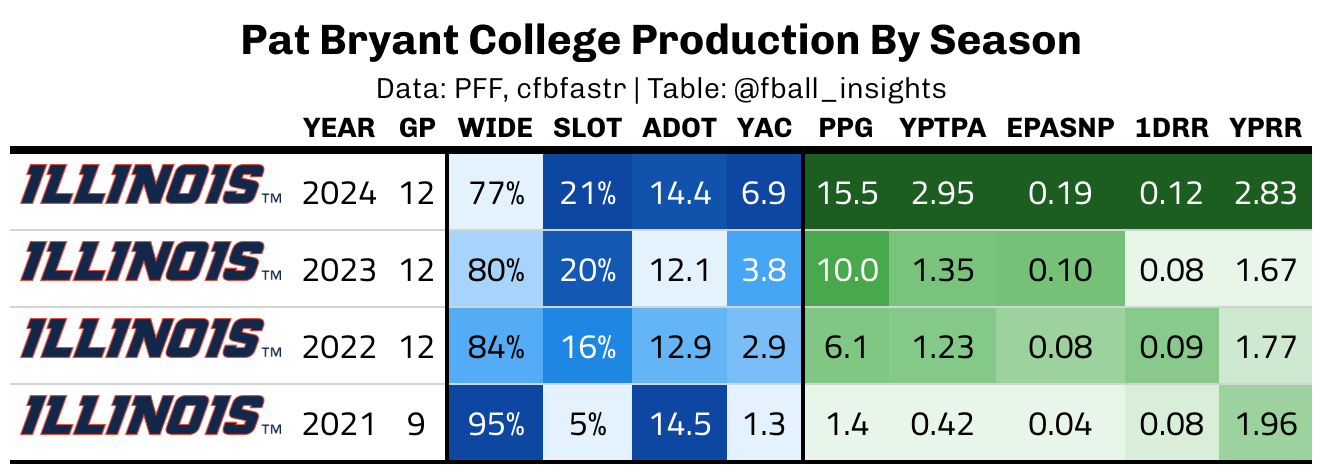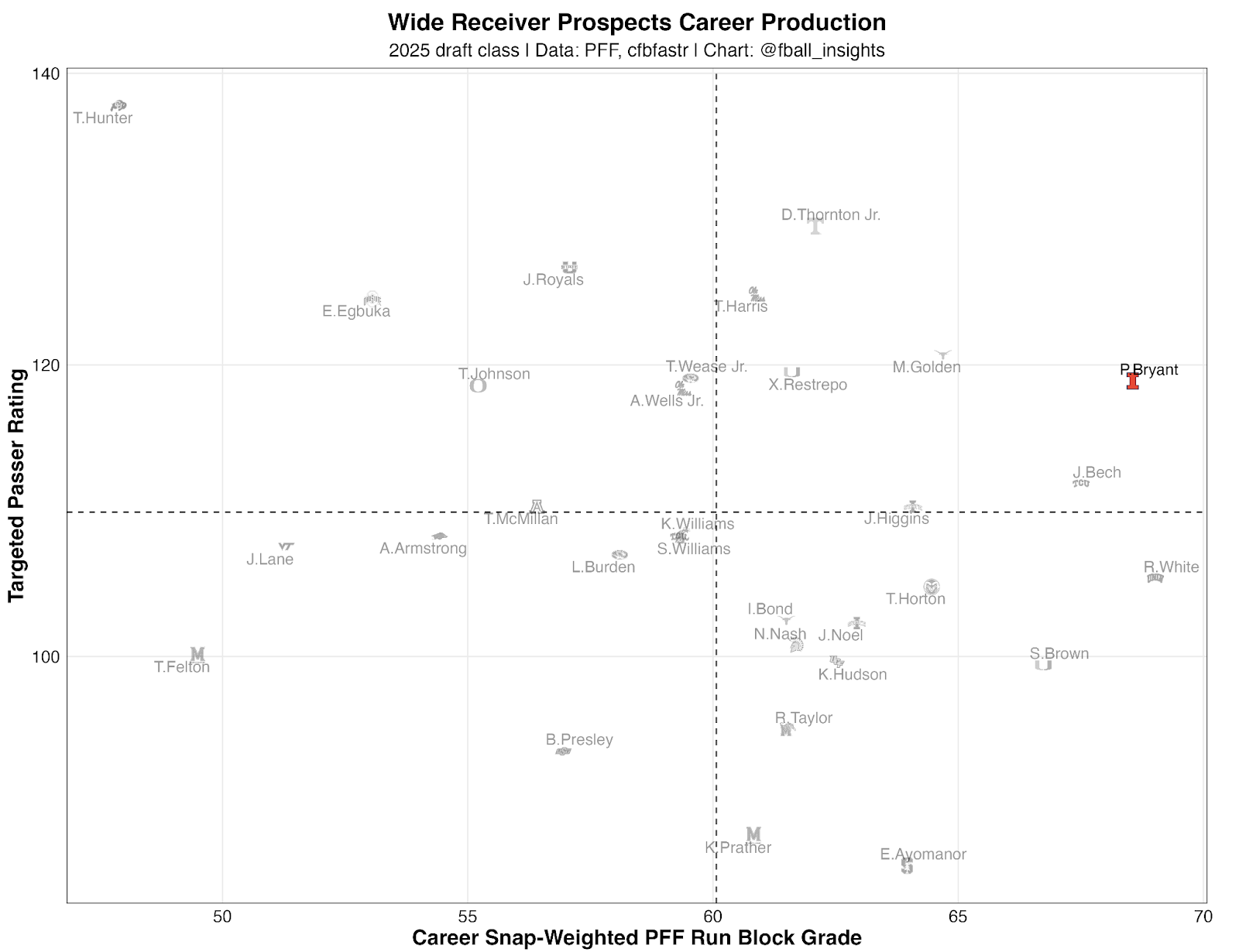What’s up, folks? It’s been a while since I checked in, so I hope you all are enjoying your football off-season!
That is… unless you consider yourself a draft junkie. In which case, I know you’re absolutely locked in.
This is the first of a series of articles I will write on draft prospects for Fantasy Points, mostly focused on wide receivers.
This article and the foreseeable ones are centered around wide receivers. The plan is to cover up to four wideouts per writeup: One WR who is projected to be an early pick, one who is projected to be an early-to-middle-round pick, and finally, one or two Day Three analytics “sleepers.”
This class is tricky in one regard — there aren’t many “Tier 1” prospects, with only one in Tetairoa McMillan who seems a lock to go in the first round. However, WRs are still being drafted early in real life regardless of the perceived strength of draft classes, making it even more valuable to assess production profiles.
With all of that being said, let’s get right to it!
Tier 1: Tetairoa McMillan | Arizona
Height: 6’4” | Weight: 219 | Age: 21.9
McMillan is my WR1 in this draft class. He is a “true junior,” meaning he is three years removed from high school.
McMillan had an exceptionally productive career at Arizona, compiling 700 yards as a true freshman and 1,300+ yards during each of his final two seasons. McMillan is primarily a boundary X and physical at the catch point. He lined up out wide on >75% of his pass play snaps in each one of his college seasons, per PFF.
PPG: Half PPR fantasy points per game; YPTPA = Receiving yards per team pass attempt in games the player appeared in
Barring unexpected circumstances, McMillan will be a first-round pick. This is big for fantasy purposes, as projected draft capital is one of the most important variables in assessing fantasy prowess among WR prospects.
There’s always variance going from college to the NFL for any position, but WR production is a bit stickier than others, and McMillan checks the production/efficiency box.
McMillan averaged 1,138 receiving yards per college season. Going back to the 2019 draft, the only other WRs averaging 1,000 or more yards in college are:
Marquise Brown (1,203)
CeeDee Lamb (1,098)
Ja’Marr Chase (1,047)
Jordan Addison (1,044)
Malik Nabers (1,005)
The next highest two are DeVonta Smith (992) and A.J. Brown (991).
Most would agree it’s important to highlight areas of concern no matter how much you like a prospect. One potential area in question for McMillan is something that’s inherently a part of his game: his ability to separate and the frequency of contested targets.
McMillan owns a career 24.9% contested target percentage (PFF). Put another way, 24.9% of his overall targets were contested at the catch point, regardless of whether they were caught or not.
Among Round 1-2 WRs since the 2021 draft, the only players with a higher career contested target rate are
Alec Pierce: 33.1%
Quentin Johnston: 27.1%
Terrace Marshall Jr.: 26.5%
Keon Coleman: 26.1%
Contested target rate (percentage of targets deemed catchable) is stickier than contested catch rate (percentage of contested targets that were caught), both over time and from college to the NFL with large enough samples:
Putting it another way:
In other words, this is a list comprised of all of the greatest draft busts over this span plus only Nico Collins
— Scott Barrett (@ScottBarrettDFB) March 5, 2024
My working theory: If you're relying on contested catches, you’re probably not getting open a lot. And if you’re not consistently getting open in college, you're…
McMillan has the size and proven skills to succeed in these situations. However, garnering volume and producing a long, sustainable NFL career aren’t exactly the arcs/outcomes among WRs who rely on 50/50 balls to earn a living.
That’s not to say McMillan is reliant on contested targets. But this is just one example of a contextual data point that, in my opinion, influenced his production. And it isn’t the only one.
Arizona finished the 2024 season with a 4-8 record and found themselves in tight game scripts or playing from behind. This is part of the reason for McMillan’s insane volume and class-best counting metrics like yards per game, total EPA, etc.
McMillan is also more dominant against man coverage and in one-on-one matchups. Arizona was blitzed quite often, leading to more unstable dropback situations.
As previously stated, McMillan was a more productive receiver vs. man coverage on a per-route basis:
Among teams picking inside the top 10 of Round 1, I believe the Raiders make the best fit.
By bringing in Pete Carroll as head coach and acquiring 34-year-old Geno Smith as their starting quarterback, this team is trying to win right now. Vegas already has TE Brock Bowers, so adding a WR like Tet on the perimeter could make for interesting stress on opposing defenses.
The second-best fit inside the top 10 would be Carolina.
The Panthers have had quite the liking for big-bodied power forward WRs over recent drafts, almost none of which have turned out positive. But there are variables worth noting.
During the 2024 regular season, CAR dropped back vs man coverage at the second-highest rate among offenses (33.1%).
QB Bryce Young showed substantial improvement in his sophomore campaign, notably in the second half of the season after a stint on the bench. Young was more decisive under pressure, and as defenses continue to test the former #1 overall pick, he could use a target like McMIllan, who has shown to be a high-volume target under duress.
Tier 2: Jack Bech | TCU
Height: 6’1” | Weight: 215 | Age: 22.2
Bech is a “true senior” who compiled four college seasons across two stops — at LSU from 2021-2022 and TCU from 2023-2024.
From a production standpoint, Bech’s top output came as a true freshman in 2021 and during his final season in 2024:
But Bech is unique and needs a deeper dive. As a true freshman, Bech was a TE and played inline on 25.1% of his pass play snaps, according to PFF.
That same year, Bech led LSU in targets (67), receptions (43), and first downs (28). And it’s important to note that Malik Nabers, Brian Thomas Jr., Kayshon Boutte, and Trey Palmer were all active on that squad.
Bech projects as a big slot and is arguably the best run blocker in this class. The “chess piece” token is commonly attributed to his game, so it makes sense why he’s garnering higher projected draft capital than his production would typically warrant.
Explain to me how I can’t just call him a TE and pretend he’s a rare pass-catcher like we do with other guys? Imagine how he’d be viewed?
— Max Toscano (@maxtoscano1) February 7, 2025
The roles are not different, only the lenses we view them. It’s how we get tricked into taking guys like Dalton Kincaid in the first round. https://t.co/CAONNWEqU3
In 2024, Bech averaged 3.13 yards per route run vs/ zone coverage and 1.79 vs man coverage. There are certainly questions about his ability to win one-on-one and vs press coverage, but he’s likely to carve out a WR2/3 power slot role at the next level.
Being a plus in the run game and the other intrinsic values he provides can help him stay on the field on early downs and less obvious expected pass situations.
Theoretically, JBech could be valuable to 11 personnel-heavy units where he allows you to do more of the full playbook while staying lighter in 11 (3 WR sets).
That said, Bech still raises red flags, given his projected draft capital and production sample.
Bech owns a career 1.86 YPRR across 4 seasons (PFF). Here are the only WRs at a sub-2.0 YPRR over four-plus college seasons dating back to the 2020 NFL Draft:
| Name | School | Draft | Round | Seasons | YPRR |
| Ricky Pearsall | Florida | 2024 | 1 | 5 | 1.99 |
| Xavier Legette | South Carolina | 2024 | 1 | 5 | 1.75 |
| Ja'Lynn Polk | Washington | 2024 | 2 | 4 | 1.95 |
| Ainias Smith | Texas A&M | 2024 | 5 | 5 | 1.99 |
| Jordan Whittington | Texas | 2024 | 6 | 5 | 1.74 |
| Casey Washington | Illinois | 2024 | 6 | 5 | 1.32 |
| Cornelius Johnson | Michigan | 2024 | 7 | 5 | 1.70 |
| Devaughn Vele | Utah | 2024 | 7 | 5 | 1.51 |
| Jonathan Mingo | Ole Miss | 2023 | 2 | 4 | 1.48 |
| Michael Wilson | Stanford | 2023 | 3 | 5 | 1.77 |
| Justin Shorter | Florida | 2023 | 5 | 5 | 1.55 |
| Elijah Higgins | Stanford | 2023 | 6 | 4 | 1.68 |
| Antoine Green | North Carolina | 2023 | 7 | 5 | 1.73 |
| Tyquan Thornton | Baylor | 2022 | 2 | 4 | 1.87 |
| Kyle Philips | UCLA | 2022 | 5 | 4 | 1.74 |
| Michael Woods | Oklahoma | 2022 | 6 | 4 | 1.47 |
| Bo Melton | Rutgers | 2022 | 7 | 5 | 1.64 |
| Joshua Palmer | Tennessee | 2021 | 3 | 4 | 1.42 |
| Cornell Powell | Clemson | 2021 | 5 | 5 | 1.81 |
| Ihmir Smith-Marsette | Iowa | 2021 | 5 | 4 | 1.68 |
| Racey McMath | LSU | 2021 | 6 | 4 | 1.91 |
| Shi Smith | South Carolina | 2021 | 6 | 4 | 1.85 |
| Frank Darby | Arizona State | 2021 | 6 | 4 | 1.66 |
| Jalen Camp | Georgia Tech | 2021 | 6 | 5 | 1.56 |
| Kawaan Baker | South Alabama | 2021 | 7 | 4 | 1.78 |
| Tre Nixon | UCF | 2021 | 7 | 4 | 1.63 |
| Ben Skowronek | Notre Dame | 2021 | 7 | 5 | 1.31 |
| Chase Claypool | Notre Dame | 2020 | 2 | 4 | 1.85 |
| Van Jefferson | Florida | 2020 | 2 | 4 | 1.63 |
| Devin Duvernay | Texas | 2020 | 3 | 4 | 1.95 |
| Collin Johnson | Texas | 2020 | 5 | 4 | 1.84 |
| K.J. Osborn | Miami | 2020 | 5 | 4 | 1.67 |
| Joe Reed | Virginia | 2020 | 5 | 4 | 1.60 |
| Dezmon Patmon | Washington State | 2020 | 6 | 4 | 1.90 |
| Freddie Swain | Florida | 2020 | 6 | 4 | 1.60 |
| Tyrie Cleveland | Florida | 2020 | 7 | 4 | 1.66 |
… not exactly the upside you’d like to see out of a four-year player from a receiving output perspective.
Assuming he grabs Day 2 draft capital, Bech is still a solid add in rounds 3-4 of your rookie drafts. I’m not sure he has WR1 upside in the NFL, but his ability to impact both the run/pass game schematically adds some juice to his projected volume and opportunities.
Tier 3: Tory Horton | Colorado State
Height: 6’2” | Weight: 196 | Age: 22.3
Horton is ranked at 115 on the NFL Mock Draft Database consensus big board, which projects him to be a Day 3 selection.
Horton’s production doesn’t match the projected draft capital, so it requires a deeper dive. Horton played in five college seasons: Nevada from 2020-2021, and then Colorado State from then on. Horton appeared in just 5 games during his final season, in 2024:
Horton’s 2.46 career yards per route run ranks in the top 10 in this draft class (PFF). Additionally, Horton averaged 3.19 YPRR vs. man coverage. The only WR in last year’s draft averaging a 3.0+ YPRR against man was none other than Marvin Harrison Jr. at 3.28.
Horton’s 4.41 40-yard dash ranks 93rd percentile for his size. If Horton hadn’t gotten hurt in 2024, I think the draft community would be talking about him a lot more.
It’s important to note that his numbers primarily came vs non-power conference competition, which some sharp draft analysts significantly downgrade in their evaluations.
That said, one data point on Horton’s side is his efficiency from the slot.
Horton ran just 21% of his career routes from the slot, but owns a 2.95 career YPRR there. He posted a 3.00, 4.18, and 3.63 YPRR from the slot in each of his three seasons at Colorado State, respectively.
Horton’s “targeted separation” numbers are also noteworthy. PFF began charting college football contested-target data in 2017. The vast majority of drafted WRs since 2021 have their career numbers all occur between 2017-2024.
Horton has a 41st-percentile average depth of target and an 86th-percentile contested target rate (lower contested target rate = higher percentile number).
Among WRs at an 80th percentile contested target rate (CTT) or better and a 40th percentile ADOT or higher, a good number are reliable separators and earned targets as rookies:
| Name | School | Draft | Round | CTT percentile | ADOT percentile |
| Ladd McConkey | Georgia | 2024 | 2 | 0.85 | 0.40 |
| Tory Horton | Colorado State | 2025 | - | 0.86 | 0.41 |
| Tank Dell | Houston | 2023 | 3 | 0.87 | 0.45 |
| Ricky Pearsall | Florida | 2024 | 1 | 0.80 | 0.48 |
| Jalen McMillan | Washington | 2024 | 3 | 0.93 | 0.49 |
| Jahan Dotson | Penn State | 2022 | 1 | 0.88 | 0.56 |
| Zay Flowers | Boston College | 2023 | 1 | 0.87 | 0.62 |
| Jalin Hyatt | Tennessee | 2023 | 3 | 0.96 | 0.67 |
| Jalen Nailor | Michigan State | 2022 | 6 | 0.82 | 0.68 |
| Xavier Worthy | Texas | 2024 | 1 | 0.81 | 0.74 |
| Roman Wilson | Michigan | 2024 | 3 | 0.92 | 0.76 |
| Dez Fitzpatrick | Louisville | 2021 | 4 | 0.81 | 0.80 |
| Jameson Williams | Alabama | 2022 | 1 | 0.96 | 0.84 |
Horton’s age, non-power conference production, and 2024 injury collectively drive down his projected draft capital.
Although he has somewhat of a limited route tree, Horton’s proven efficiency from the slot as a predominantly outside WR, combined with his encouraging separation relative to his size, suggests some untapped potential heading into the NFL.
I think Horton’s numbers make him worthy of an NFL Draft flier on day 3, and a late-round or undrafted-free-agent gem in your dynasty rookie drafts.
Tier 3: Pat Bryant | Illinois
Height: 6’2” | Weight: 204 | Age: 22.2
Bryant, a true senior, played all four of his college seasons in Champaign, something that’s become quite rare to see in the NIL era.
Bryant is a more traditional X without much alignment flexibility, at least in terms of production. Fewer than 20% of his career routes came from the slot, where he posted just 1.78 yards per route run according to PFF.
Bryant also isn’t going to beat you with speed or explosion after the catch:
Pat Bryant is a WR prospect in the 2025 draft class. He scored a 6.92 #RAS out of a possible 10.00. This ranked 1063 out of 3445 WR from 1987 to 2025.
— Kent Lee Platte (@MathBomb) March 11, 2025
Pro day pending for remaining tests.https://t.co/LL8IqAMKoe pic.twitter.com/McUUMkY1hR
Where Bryant adds substantive value is in contested catch situations and as a run blocker. Among drafted WRs since 2021, Bryant is 85th percentile in contested catch rate (54.8%).
As a run blocker, Bryant grades out second-best in this WR draft class:
Bryant currently ranks 171st on consensus mock drafts, projecting him as almost certainly a Day 3 selection
His hands, physicality at the catch point, and run-blocking abilities on the perimeter collectively make him a viable early down deployment player and inside the red zone.
In dynasty formats, Bryant is a worthy UDFA pickup to stash on expanded benches. Nick Westbrook-Ikhine is one of Bryant's more logical production comps.



